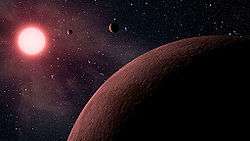Kepler-42
 Artist's impression of the Kepler-42 (KOI-961) system Credit: NASA | |
| Observation data Epoch J2000 Equinox J2000 | |
|---|---|
| Constellation | Cygnus |
| Right ascension | 19h 28m 52.56s[1] |
| Declination | 44° 37′ 0.96″[1] |
| Apparent magnitude (V) | 16.12[2] |
| Characteristics | |
| Spectral type | M5V[3] |
| Astrometry | |
| Radial velocity (Rv) | −84.48±0.2[3] km/s |
| Proper motion (μ) | RA: 84[1] mas/yr Dec.: −423[1] mas/yr |
| Distance | 126±20.5[3] ly (38.7±6.3 pc) |
| Details | |
| Mass | 0.13±0.05[3] M☉ |
| Radius | 0.17±0.04[3] R☉ |
| Luminosity | 2.40x10−3.0±0.3 L☉ |
| Temperature | 3068±174[3] K |
| Metallicity | [Fe/H] =−0.48±0.17[3] |
| Rotational velocity (v sin i) | 2.9±0.4[3] km/s |
| Other designations | |
2MASS J19285255+4437096, USNO-B1.0 1346-00336634, KIC 8561063, LSPM J1928+4437 | |
Kepler-42, formerly known as KOI-961, is a red dwarf located in the constellation Cygnus and approximately 126 light years from the Sun. It has three known extrasolar planets, all of which are smaller than Earth in radius,[4] and likely also in mass.
Characteristics
Kepler-42's mass is estimated to be 0.13 times that of the Sun, and to have a radius 0.17 times that of the Sun, that is, just 1.7 times that of the gas giant Jupiter. Due to its small radius and hence surface area, the luminosity of Kepler-42 is only 0.24% of that of the Sun. Its metallicity is one third of the Sun. Kepler-42 has an appreciable proper motion of up to 431±8 mas/yr.[3] Due to its small size and low temperature, the star's habitable zone is much closer to the star than Earth is to the Sun.
Planetary system


On 10 January 2012, using the Kepler Space Telescope three transiting planets were discovered in orbit around Kepler-42. These planets' radii range from approximately those of Mars to Venus. The Kepler-42 system is only the second known system containing planets of Earth's radius or smaller (the first was the Kepler-20 system pictured at left). These planets' orbits are also compact, making the system (whose host star itself has a radius comparable to those of some hot Jupiters) resemble the moon systems of giant planets such as Jupiter or Saturn more than it does the Solar System. Despite these planets' small size and the star's being one of the faintest stars in Kepler field with confirmed planets, the detection of these planets was possible due to small size of the star, causing these planets to block a larger proportion of starlight during their transits.
Not all of the orbital parameters of the system are known. For example, as with all transiting planets that have not had their properties established by means of other methods such as the radial velocity method, the orbital eccentricity remains unknown.
Based on the orbits of the planets and the luminosity and effective temperature of the host star, the equilibrium temperatures of the planets can be calculated. Assuming an extremely high albedo of 0.9 and absence of greenhouse effect, the outer planet Kepler-42 d would have an equilibrium temperature of about 280 K (7 °C),[5] similar to Earth's 255 K (−18 °C).[6] Estimates for the known planets are in the tables below:
| Temperature comparisons |
Kepler-42c | Kepler-42b | Kepler-42d | Earth |
| Global equilibrium temperature | 728 K 455 °C 851 °F | 524 K 251 °C 483.8 °F | 454 K 181 °C 357.8 °F | 255 K −18 °C −0.4 °F |
| References:[5][note 2] | ||||
| Companion (in order from star) |
Mass | Semimajor axis (AU) |
Orbital period (days) |
Eccentricity | Inclination | Radius |
|---|---|---|---|---|---|---|
| c | <2.06 M⊕ | 0.006 | 0.45328509 ± 9.7x10−7 | 0 | — | 0.73 ± 0.20 R⊕ |
| b | <2.73 M⊕ | 0.0116 | 1.2137672 ± 4.6x10−6 | 0 | — | 0.78 ± 0.22 R⊕ |
| d | <0.9 M⊕ | 0.0154 | 1.856169 ± 1.4x10−5 | 0 | — | 0.57 ± 0.18 R⊕ |
Notes
References
- 1 2 3 4 "KOI-961". SIMBAD. Centre de données astronomiques de Strasbourg. 2012-01-11. Retrieved 2012-01-19.
- 1 2 "Star: KOI-961 – 3 PLANETS". Extrasolar Planets Encyclopaedia. 2012-01-12. Retrieved 2012-01-12.
- 1 2 3 4 5 6 7 8 9 Philip S. Muirhead; John Asher Johnson; Kevin Apps; Joshua A. Carter; Timothy D. Morton; Daniel C. Fabrycky; J. Sebastian Pineda; Michael Bottom; Barbara Rojas-Ayala; Everett Schlawin; Katherine Hamren; Kevin R. Covey; Justin R. Crepp; Keivan G. Stassun; Joshua Pepper; Leslie Hebb; Evan N. Kirby; Andrew W. Howard; Howard T. Isaacson; Geoffrey W. Marcy; David Levitan; Tanio Diaz-Santos; Lee Armus; James P. Lloyd (2012). "Characterizing the Cool KOIs III. KOI-961: A Small Star with Large Proper Motion and Three Small Planets". arXiv:1201.2189
 [astro-ph].
[astro-ph]. - 1 2 "KOI-961: A Mini-Planetary System". NASA Ames Research Center Kepler, A Search for Habitable Planets. NASA Ames Research Center Kepler. 2012-01-11. Retrieved 2012-01-11.
- 1 2 "Planet Equilibrium Temperature". Habitable Exoplanets Catalog. Planetary Habitability Laboratory at the University of Puerto Rico. Retrieved 29 February 2012.
- ↑ "Radiating Equilibrium Temperature". University of Wisconsin Marathon County - Department of Geology/Geography. Retrieved 29 February 2012.
- ↑ http://kepler.nasa.gov/Mission/discoveries/